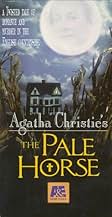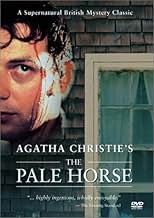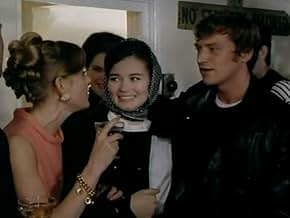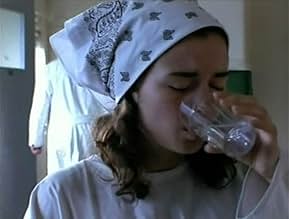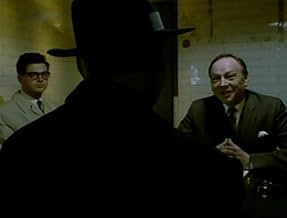Aggiungi una trama nella tua linguaWhen Mark Easterbrook finds himself in the frame for the murder of a priest, there seems no way to prove his innocence other than solving the mystery himself.When Mark Easterbrook finds himself in the frame for the murder of a priest, there seems no way to prove his innocence other than solving the mystery himself.When Mark Easterbrook finds himself in the frame for the murder of a priest, there seems no way to prove his innocence other than solving the mystery himself.
- Regia
- Sceneggiatura
- Star
Richard O'Callaghan
- Donald
- (as Richard O' Callaghan)
Recensioni in evidenza
This is a 1997 version of "The Pale Horse," based on the 1961 novel of the same name by Agatha Christie.
Ariadne Oliver is in the book, but she's not in this production.
The story concerns a sculptor, Mark Easterbrook, who finds a priest dying in an alley. The priest has a list of names. When the police arrive, they take the list away from Easterbrook and accuse him of murder.
He and an art restorer, Kate Mercer, work to prove his innocence, using whatever Mark remembers of the list. He's shocked to learn that everyone on the list is dead, save one, and all from natural causes.
Mark and Kate are led to a house called "The Pale Horse," where three women who claim to be witches live. Can their spells actually kill people? What about the booking agent Mark meets? Can he think someone dead, or does he set it up? This could have been a more interesting story, but it isn't, due to the fact that it's somewhat confusing. Also, while some of the women's clothing appears to be from the '60s, nothing else seemed very '60s to me with Easterbrook walking around wearing a leather jacket. The era is amorphous.
The acting was okay. I enjoyed seeing Hermoine Norris in a different kind of role from the one she played on MI-5 and her character on Wire in the Blood. She was very good. Also, Michael Byrne and Leslie Phillips give outstanding performances. The rest of the acting was so-so, as were the production values.
After watching the Hercule Poirot series, it's hard to go back to anything less than the characterizations, production values, and costumes found in them.
Ariadne Oliver is in the book, but she's not in this production.
The story concerns a sculptor, Mark Easterbrook, who finds a priest dying in an alley. The priest has a list of names. When the police arrive, they take the list away from Easterbrook and accuse him of murder.
He and an art restorer, Kate Mercer, work to prove his innocence, using whatever Mark remembers of the list. He's shocked to learn that everyone on the list is dead, save one, and all from natural causes.
Mark and Kate are led to a house called "The Pale Horse," where three women who claim to be witches live. Can their spells actually kill people? What about the booking agent Mark meets? Can he think someone dead, or does he set it up? This could have been a more interesting story, but it isn't, due to the fact that it's somewhat confusing. Also, while some of the women's clothing appears to be from the '60s, nothing else seemed very '60s to me with Easterbrook walking around wearing a leather jacket. The era is amorphous.
The acting was okay. I enjoyed seeing Hermoine Norris in a different kind of role from the one she played on MI-5 and her character on Wire in the Blood. She was very good. Also, Michael Byrne and Leslie Phillips give outstanding performances. The rest of the acting was so-so, as were the production values.
After watching the Hercule Poirot series, it's hard to go back to anything less than the characterizations, production values, and costumes found in them.
I think those who despised this mini series must be Agatha Christie purists. I've never read her; don't care much for mysteries though I know she is revered. So I went into this brief series with low expectations and did n-o-t feel it was the trainwreck others had. Love Sewell in everything so that was a plus. Even liked the ending. It was watchable, perhaps because it reminded me a bit of Wicker Man or just for whatever reason...I did not hate it, nope not at all.
A lesser Christie story in a distinctly lesser adaptation.
The trouble starts with "The 60s". Christie published the book in 1961 but was still writing classic Christie-style stories that really only work to their best in a pre-war setting as per Suchet-Poirot. Hickson-Marple got away with the 50s by pretending little had changed since the 30s (and had the sense to set the 60s Marples in their version of the 50s alongside the others) but in both cases the result was the same: a comforting historical atmosphere that can make some poor plotting and characters forgiveable. But few people have charming fantasies about the 60s so the story has to hold the attention that much more securely: a tough job even with a major story and/or well-loved characters, both of which this film lacks.
The attempt at doing the 60s in this case is also pretty ham-fisted: book 1961, coffin lid 1964, mini dresses and knee boots scream 1967; hospital bedside electronics suggests 80s at least.
So with no convincing period atmosphere to fall back on, the weak plot with too few suspects and too many gaps is laid rather bare.
Even given these issues, all might not have been lost with stronger main characters but Colin Buchanan is simply not leading material. Jayne Ashbourne is arrestingly pretty and her easy naturalness could have made a great contribution given a powerful male lead and more dynamic script but as it is she just hovers unproductively.
In summary, it is watchable despite rather than because of itself but could have been much better for the same money if the producers had simply used a bit of common sense, set it in 1997, and spent the mini-skirt budget on a better leading man and a decent script editor.
The trouble starts with "The 60s". Christie published the book in 1961 but was still writing classic Christie-style stories that really only work to their best in a pre-war setting as per Suchet-Poirot. Hickson-Marple got away with the 50s by pretending little had changed since the 30s (and had the sense to set the 60s Marples in their version of the 50s alongside the others) but in both cases the result was the same: a comforting historical atmosphere that can make some poor plotting and characters forgiveable. But few people have charming fantasies about the 60s so the story has to hold the attention that much more securely: a tough job even with a major story and/or well-loved characters, both of which this film lacks.
The attempt at doing the 60s in this case is also pretty ham-fisted: book 1961, coffin lid 1964, mini dresses and knee boots scream 1967; hospital bedside electronics suggests 80s at least.
So with no convincing period atmosphere to fall back on, the weak plot with too few suspects and too many gaps is laid rather bare.
Even given these issues, all might not have been lost with stronger main characters but Colin Buchanan is simply not leading material. Jayne Ashbourne is arrestingly pretty and her easy naturalness could have made a great contribution given a powerful male lead and more dynamic script but as it is she just hovers unproductively.
In summary, it is watchable despite rather than because of itself but could have been much better for the same money if the producers had simply used a bit of common sense, set it in 1997, and spent the mini-skirt budget on a better leading man and a decent script editor.
Agatha Christie's "The Pale Horse" is not one of my favorite Christie books. There is no Poirot or Miss Marple to liven things up, and the witchcraft motif seems contrived.
The film of the same name is a 1997 British TV production, loosely based on Christie's novel. I wasn't expecting much from this film, and not much was what I got. The film's confusing plot meanders around, seemingly without direction. There are too few suspects. And the ending is a letdown, and potentially unclear for anyone not familiar with the book.
On the other hand, the acting is OK, though a bit hammy at times. And the film has good production design.
Overall, this film is not terribly bad. But it's not particularly good either. There are other Agatha Christie movies out there that are so much better. If these films were in competition with each other, most of them would leave "The Pale Horse" at the starting gate.
The film of the same name is a 1997 British TV production, loosely based on Christie's novel. I wasn't expecting much from this film, and not much was what I got. The film's confusing plot meanders around, seemingly without direction. There are too few suspects. And the ending is a letdown, and potentially unclear for anyone not familiar with the book.
On the other hand, the acting is OK, though a bit hammy at times. And the film has good production design.
Overall, this film is not terribly bad. But it's not particularly good either. There are other Agatha Christie movies out there that are so much better. If these films were in competition with each other, most of them would leave "The Pale Horse" at the starting gate.
"The Pale Horse" is based on a late mystery novel by Agatha Christie. By 1961, her two most famous detectives had become immortalized with many novels and short stories. She would still have a few more mysteries to write about Hercule Poirot and Miss Marple as she was winding down her writing career. And with only a dozen films having been made based on her stories, there were another dozen in store before her death in 1976. But modern fans will be most familiar with the several dozen feature films and TV movies from the1970s through the first two decades of the 21st century. Of those, Hercule Poirot and Miss Marple appear in the vast majority.
This movie is quite different just in having all new characters with a very good plot. Black magic was a draw for her novel of the same title and the film. But it differs from the book in some characters, including not having Ariadne Oliver in a small part.
Christie wove a very interesting plot here. She wrote several mysteries around the supernatural, including black magic and witches. But Christie fans learn early to not suspect the dark characters of being the actual culprits in her stories. I did have suspicions about one outcome, but I really missed the conclusion and who the villain was.
The film seems to be updated to the late 1990s in England when it was made. I aways prefer her Poirot and all of her characters and plots to be set in the older and original times. Mystery fans especially should enjoy this film.
This movie is quite different just in having all new characters with a very good plot. Black magic was a draw for her novel of the same title and the film. But it differs from the book in some characters, including not having Ariadne Oliver in a small part.
Christie wove a very interesting plot here. She wrote several mysteries around the supernatural, including black magic and witches. But Christie fans learn early to not suspect the dark characters of being the actual culprits in her stories. I did have suspicions about one outcome, but I really missed the conclusion and who the villain was.
The film seems to be updated to the late 1990s in England when it was made. I aways prefer her Poirot and all of her characters and plots to be set in the older and original times. Mystery fans especially should enjoy this film.
Lo sapevi?
- BlooperA few lines of dialogue use expressions from the 90s, and wouldn't have been known in the 60s. Most prominent example is Corrigan's saying "Enjoy!"
- Citazioni
Thyrza Grey: Only death solves all problems; only death gives true peace. Death is the great ecstasy.
- ConnessioniReferences Lolita (1962)
I più visti
Accedi per valutare e creare un elenco di titoli salvati per ottenere consigli personalizzati
Dettagli
- Data di uscita
- Paese di origine
- Lingue
- Celebre anche come
- Un cavallo per la strega
- Luoghi delle riprese
- Aziende produttrici
- Vedi altri crediti dell’azienda su IMDbPro
Contribuisci a questa pagina
Suggerisci una modifica o aggiungi i contenuti mancanti

Divario superiore
By what name was The Pale Horse (1997) officially released in Canada in English?
Rispondi
